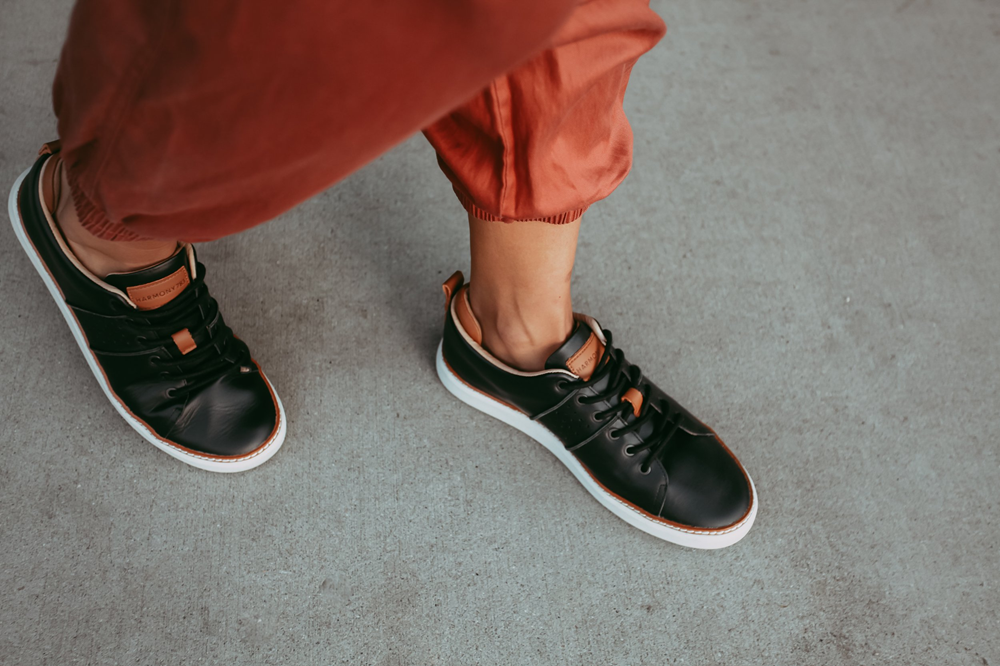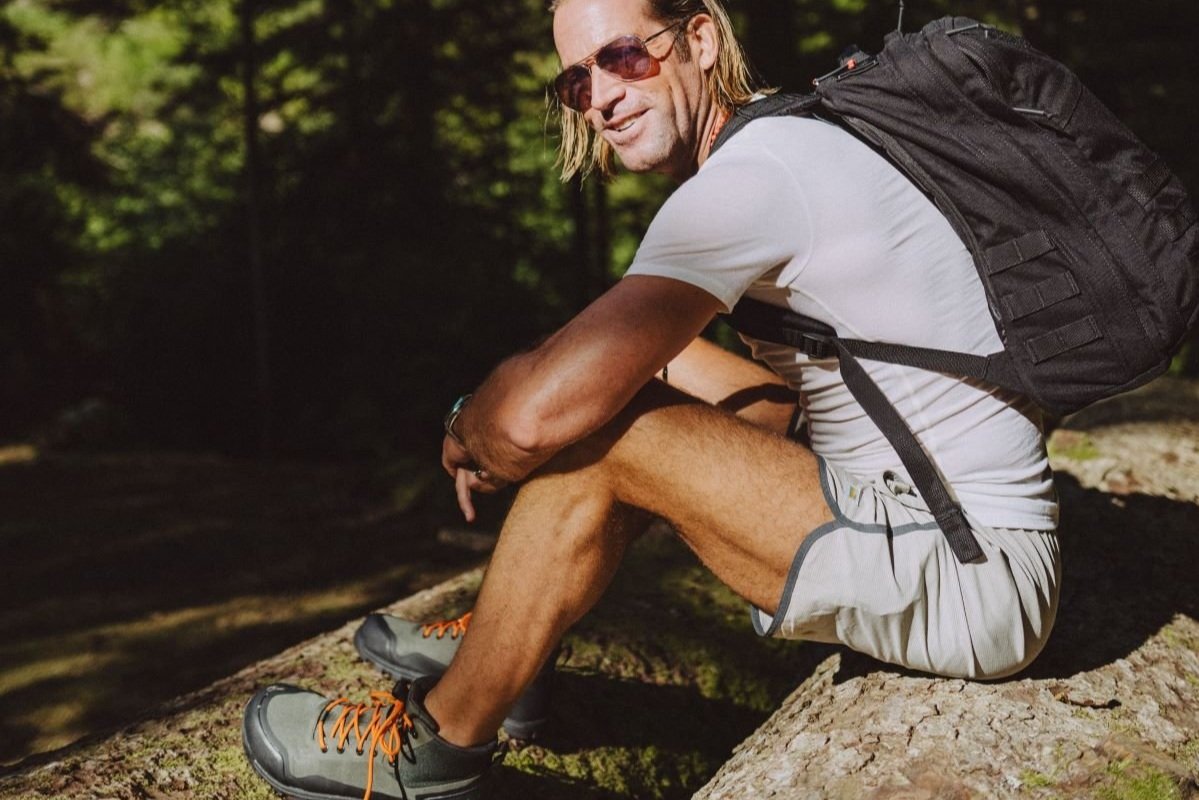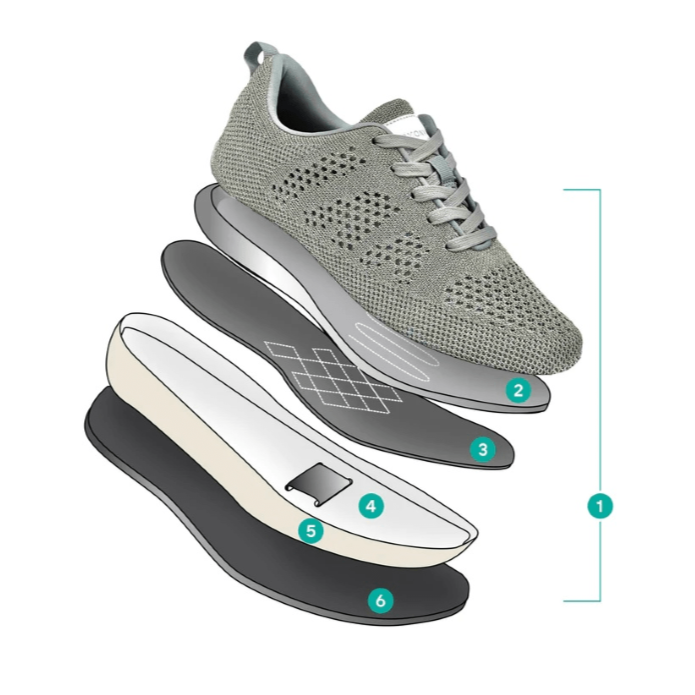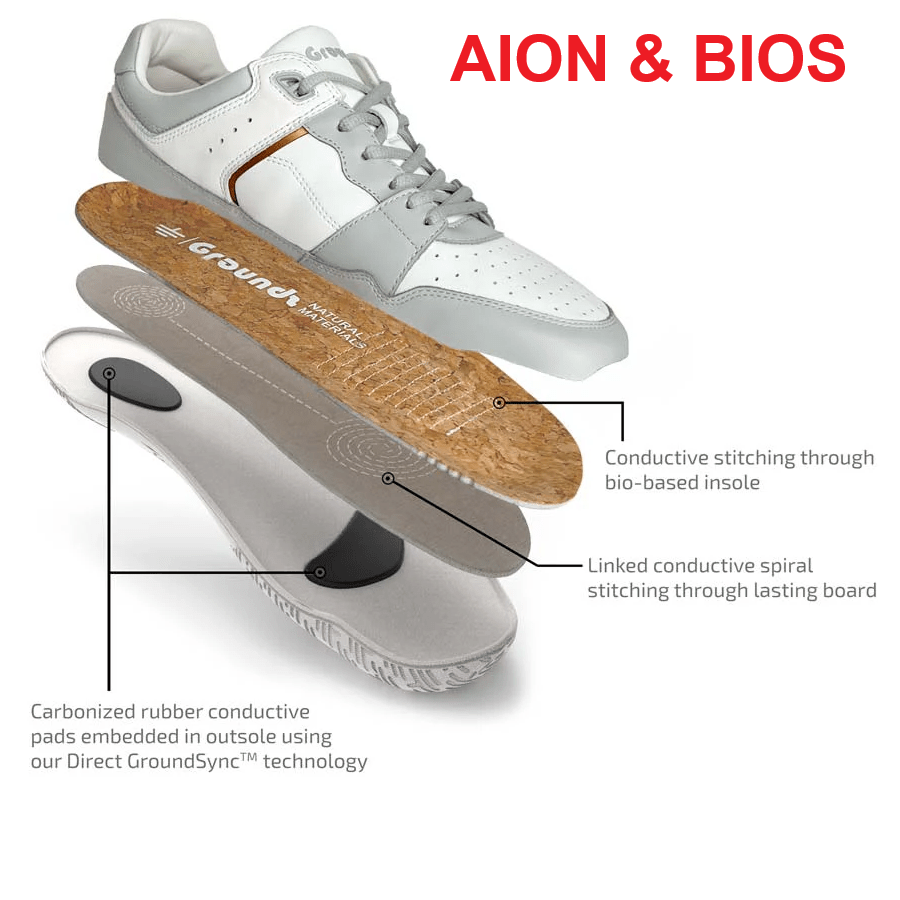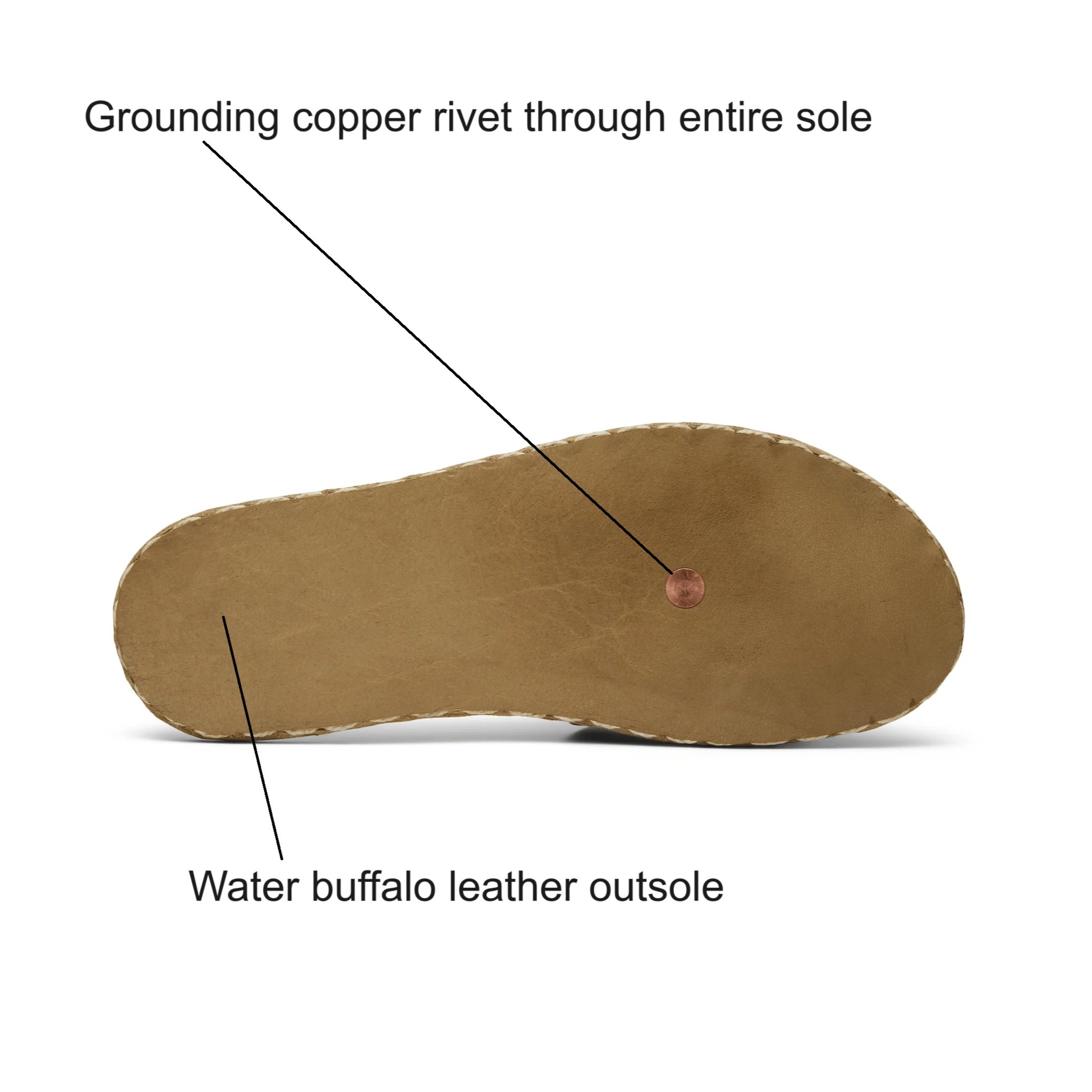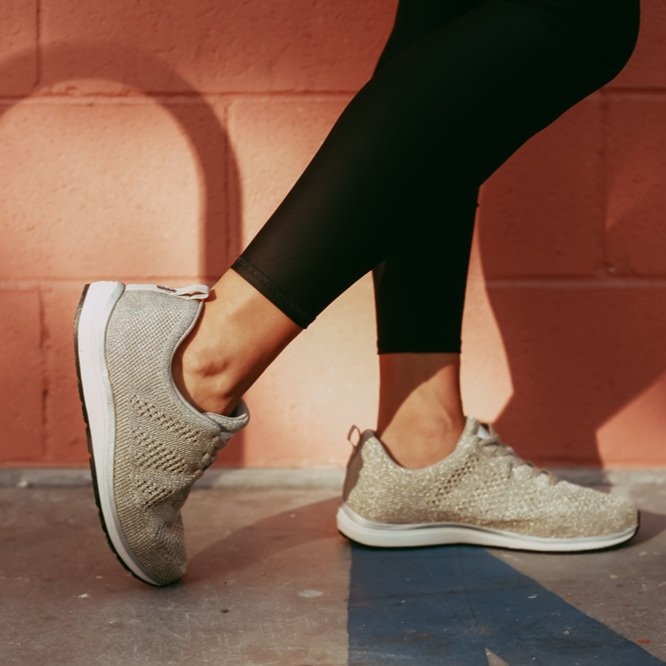How a Frugal Health Enthusiast Became a Grounding Shoe Convert
You know about the benefits of soaking up Earth’s natural energy, a practice known as grounding, or Earthing, and try to connect as much as possible. But going barefoot isn’t always in your cards. You learn (perhaps through this site) that you can get special shoes that keep you grounded on natural earth surfaces, so you do some shopping. And then you see the grounding shoe prices and have sticker shock. You might just decide to stop there and buy nothing.
I’ve been there, which is why I wanted to write this blog… As someone who’s been into grounding for the last 14 years, I’m crystal clear on why grounding shoes are good for my feet and whole body. But with all my research and experience, I was still taken aback by the prices the first time I shopped for grounding footwear online. I simply wasn’t accustomed to paying more than $75 for a pair of sneakers or sandals - even well-made ones, and had a hard time swallowing price tags of up to $220 per pair.
Shown here are Harmony 783 Black Leather Walkers.
The turning point was when a friend gave me a new pair of Harmony 783 wool Joggers. I was thrilled at how nice they looked and well they fit (I have always struggled to find truly comfortable sneakers). Not to mention, I felt great wearing them. However, since these were now my “good shoes” (and I was aware of how much they cost), I didn’t wear them often because I didn’t want to get them dirty.
Mountain exploring in Harmony 783 Brown Leather Walkers
Then one day I went for a long hike in the woods with my dog, wearing my Joggers. I had an argument with my husband earlier that day and needed to blow off some steam. About 30 minutes into that walk, I started to feel a subtle wave of relaxation and calm flow through me. Yes, the exercise certainly was part of that, as was being out in the woods, but the shoes brought that exercise-in-nature high to a new level. From that day forward, I always wore those shoes when walking in the forest. And because nature can be dirty, muddy and ticky, I decided to buy myself another pair for around-town wear. I jumped the price hurdle, treated myself and invested in my health and wellbeing. I am now on my third pair of Harmony 783 Joggers, and still wear the (now-discontinued) wool pairs I got several years ago.
Over the last five years, my grounding shoe collection has grown to include at least 20 pairs made by all the grounding shoe brands we recommend here at Grounded.com. Admittedly, I received some of these grounding shoes for free; most I paid full price for or bought when on sale or through a promotion.
Step hikes all around Europe in Bahé Rediscover Grounding Boots
All have become VIPs (Very Important Pedi-Wear) in my closet because they help keep me connected to that restorative Earth energy. I still go barefoot whenever possible, but cold weather and uncomfortable conductive surfaces often prove challenging.
I’ve now donated most of my other, traditional shoes because I only want to wear grounding, or functional, shoes. Once I went grounded, regular shoes lost their allure.
Step’s in a similar place with several new pairs of custom, hand-made leather shoes that he bought in Florence, Italy. He was living there for a spell and got to know the shoe makers, and even picked out expensive leather…but he has no desire to wear them anymore now that he’s got grounding shoes to choose from.
Although he goes barefoot more often than most, Step always chooses grounding shoes over regular shoes when shoes are in the cards. This is a simple decision - he knows regular shoes disconnect him from the earth energy that helps him feel his best.
So logic has made us grounding shoe addicts. Step had been pushing me to try the shoes for years because of the profound restorative impact grounding has had on his health. I’m glad I listened, even if I do pay more for shoes now. The price is worth it. Here’s why…
Grounding Shoes Are Made Using Revolutionary New Technologies
Harmony 783 proprietary grounding technology with conductive carbonized rubber and silver stitching.
Groundz grounding sneaker tech
Bahe grounding tech
Earth Runners grounding tech
You likely know that things produced in mass quantities are much cheaper to make than small-batch products. This is because big manufacturers already have systems in place and production minimums that are much higher than what a niche market can support. It’s not worth their time and effort to bother with small shoe companies, let alone ones that require alternate materials and production methods to make ground conductivity possible.
The grounding shoe companies we know are small businesses founded by grounding enthusiasts who are passionate about making shoes that help people look and feel their best. Their shoes aren’t produced in giant, overseas factories. The companies we recommend make their shoes in small batches with special materials using a revolutionary new technologies. They didn’t have the benefit of existing assembly line machinery and tools. They had to figure it out themselves, and they did.
Raum grounding tech
“It’s taken a decade to really get these shoes off the ground…literally! Before that, our only grounding shoe options were sandals or flip flops or do-it-yourself models that wore out quickly. The inflection point has happened…and there is no going back. We firmly believe grounding shoes will make a huge impact or FOOTPRINT on the entire shoe industry in the next decade.”
Some Grounding Shoes Are Handmade Using High-Quality Materials
When is the last time you bought a pair of regular shoes that was 100% artisan made by hand? Until I started wearing select shoes by Groundz and Raum, I was in the “never” category too (as of fall 2025, only Groundz slip-on grounding shoes are handcrafted).
It’s hard to get a true sense of the craftsmanship of such all-natural, handmade shoes when looking at them online. But when you see them in person, notice the meticulous stitching, and feel the soft suede and smooth leather in your hands and around your feet, you get a better sense of just how much work went into making them. They are truly special shoes.
California-based Raum commissions expert artisans in Turkey to hand-craft their leather-soled grounding shoes with copper rivets. Over 200 steps comprise the Raum all-natural shoe-making process - you can learn more about it here.
Some Earthing Shoes are Made Just for You
In this age of consumerism, it’s challenging to buy products that aren’t mass produced. That’s what makes small businesses like Earth Runners really stand out. Their grounding shoes are not only produced in the USA in their California facility; each pair is actually made to order! This means it might take a few weeks longer for your shoes to arrive, but they are truly one of a kind.
Other small business grounding shoe brands, like Raum and Groundz, produce their lines of hand-crafted, leather shoes in very small batches, making them rarer commodities. Some, like Harmony 783 and Bahé, utilize pre-ordering of new styles to make sure they are only generating what is needed. Such helps reduce waste and keeps production sustainable, which leads me to my next point…
MOST Grounding Shoe Companies Are Committed to Sustainability
Step and I with our Groundz BIOS
If you’re reading this, you’re likely into grounding, and thus probably have an appreciation and love for this healing Earth. Perhaps you feel a responsibility to live in ways that support Earth’s longevity along with your own. For many, grounding and sustainability go hand in hand. If we pollute the Earth with waste and toxicity, how will it continue to help us sustain our health and vitality?
The grounding shoe brands we feature all utilize methods to minimize their environmental footprint. As grounding enthusiasts, it seems to be in their DNA to do so. Whether it’s making shoes the old-fashioned way from the most natural and least synthetic materials available, using eco-friendly technologies, shipping in recyclable or reusable packaging, and/or donating a percentage of all sales to organizations that honor the Earth or its indigenous cultures, the grounding shoe brands we recommend are doing their part.
More on each brand’s sustainable practices here:
Harmony 783 – uses mindfully-sourced materials, including bio-friendly packaging; also donates to the National Forest Foundation’s Sapling Program.
Bahé – uses plant-based materials like corn, sugarcane and organic cotton, as well as recycled polyester mesh, to make their running shoes.
Raum - uses all-natural, non-synthetic materials in their 100% handmade, hand-stitched shoes, and all leathers are food-industry bi-products. Raum also is an official member of 1% For the Planet, which means that they donate 1% of their yearly sales to nonprofits and charities aligned with their values.
Groundz – uses all-natural, sustainable or recyclable materials. We also love that Groundz shoes are shipped in a simple, compostable bag.
Step in all-natural Raum leather-soled grounding slip ons
Earth Runners Grounding Sandals are waterproof!
Earth Runners – Besides making shoes that encourage people to spend more time in nature, Earthrunners donates a percentage of all sales to benefit the Tarahumara, from which their minimal sandal design originated.
Many Grounding Shoes Are Minimalist / Barefoot Design
Until Step turned me on to grounding shoes, I was unfamiliar with minimalist, or barefoot design, shoes. Then I tried on a pair of Groundz slip ons, and got the memo…it was a very different and pleasing fit.
Groundz slip ons and sneakers - elements of barefoot design
What exactly is “barefoot design”? Minimalist shoes have thinner, “zero-drop” soles and wide toe boxes. Zero drop means there’s no height difference between sole of the heel and front of foot – essentially a flat sole with zero arch support. A wide toe box offers more room for the toes to all spread out instead of cramming them into a pointy, slimmer toe box. The soles are also thinner and more flexible so you can better feel the ground beneath your feet. Barefoot design is the diametric opposite of women’s slingback heels and a world away from orthopedic shoes.
Is barefoot design necessarily better for you? Proponents argue, yes, because regular, long-term use can help strengthen the feet and make people less prone to flat foot. Research supports these claims, and also shows that minimalist shoes are associated with better mobility and stability in people with a history of falls (see references 1-5).
As for running in barefoot design shoes, there’s some evidence to show reduced risk of injuries; however, per a 2014 systematic review (reference 6 below), the evidence isn’t strong enough to draw any conclusions about safety – more research is needed.
Having walked all summer in my Groundz shoes and Earth Runner sandals, I have come to very much enjoy barefoot design shoes and am curious to see if donning them will make my low back happier in the long run – time will tell.
For those who prefer a cushioned sole with more arch support, barefoot design may seem like a recipe for discomfort - a huge step away from the norm. Many Harmony 783 shoe styles offer medium arch support and are great options for people who want that extra cushioning (I still love wearing mine because they’re so comfortable and stylish).
Of the shoe brands we recommend, four are now dedicated to making barefoot-design footwear – Groundz, Earth Runners, Bahé, and Softstar (though only a few Softstar styles are grounded).
At the end of the day, since barefoot design isn’t quite mainstream, it can mean a higher price tag due to increased production costs. Couple that with grounding functionality, and you can see that these small shoe companies have made leaps and bounds to help bring you the healthiest shoes possible. They spend more to get these functional shoes made than bigger shoe brands, and as a result, need to charge more.
Harmony 783 Walkers, Sneakers, Joggers (shown here), Trail Shoes and Sandals all offer medium arch support, some with padded memory foam arches and heels for cushioned support.
It's important to note that not all grounding shoes are barefoot design, and not all minimalist shoes deliver an infusion of earth energy into the feet similar to going barefoot. If having both weighs into your decision to purchase a particular pair of shoes, be sure to read product pages closely.
Learn more in this related blog: Are Grounded Shoes the Same as Barefoot-Design Shoes?
Grounding Shoes: A Valuable Investment
We hope this page has helped shine light on grounding shoe costs and the value of these shoes as investments in your health and wellbeing. Superior materials, sustainability, and novel designs and functionality are just some of the reasons why you really get more for your money with grounding shoes. More importantly, if wearing grounding shoes instead of non-conductive footwear actually improves your health, isn’t that result worth far more than the price paid?
We choose to promote various grounding shoe brands, not just because we love their shoes, but because we appreciate their small business values:
Providing superior quality products that support good health
Getting back to nature while protecting the environment
Offering products they (and we) can feel great about, and
Living the dream through passion, hard work and ingenuity.
If the shoe fits your value system too, then…well, you get the picture :>)
Happy trails…they’re better when grounded!
Page last updated: November 7, 2025.
Disclosure: This page contains affiliate links and we may earn commissions when you purchase via such links on this page. We only recommend brands we wear ourselves and have found to be effective. As grounding shoe converts, we will always choose grounding shoes over regular shoes whenever possible…because once you go grounded, it’s hard to go back to ungrounded shoes!
References:
1. Curtis R, Willems C, Paoletti P, D'Août K. Daily activity in minimal footwear increases foot strength. Sci Rep. 2021 Sep 20;11(1):18648. doi: 10.1038/s41598-021-98070-0. PMID: 34545114; PMCID: PMC8452613.
2. Cudejko, T., Gardiner, J., Akpan, A. et al. Minimal shoes improve stability and mobility in persons with a history of falls. Sci Rep 10, 21755 (2020). https://doi.org/10.1038/s41598-020-78862-6
3. Holowka, N.B., Wallace, I.J. & Lieberman, D.E. Foot strength and stiffness are related to footwear use in a comparison of minimally- vs. conventionally-shod populations. Sci Rep 8, 3679 (2018). https://doi.org/10.1038/s41598-018-21916-7
4. Miller E., Whitcome K., et al. The effect of minimal shoes on arch structure and intrinsic foot muscle strength, Journal of Sport and Health Science, Volume 3, Issue 2, 2014, Pages 74-85, ISSN 2095-2546, https://doi.org/10.1016/j.jshs.2014.03.011
5. Ridge ST, Olsen MT, Bruening DA, Jurgensmeier K, Griffin D, Davis IS, Johnson AW. Walking in Minimalist Shoes Is Effective for Strengthening Foot Muscles. Med Sci Sports Exerc. 2019 Jan;51(1):104-113. doi: 10.1249/MSS.0000000000001751. PMID: 30113521.
6. Perkins KP, Hanney WJ, Rothschild CE. The risks and benefits of running barefoot or in minimalist shoes: a systematic review. Sports Health. 2014 Nov;6(6):475-80. doi: 10.1177/1941738114546846. PMID: 25364479; PMCID: PMC4212355.


